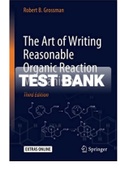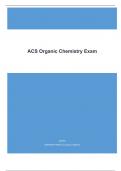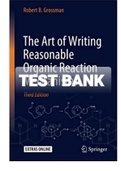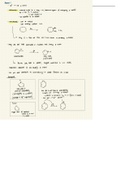Antiaromatic - Study guides, Class notes & Summaries
Looking for the best study guides, study notes and summaries about Antiaromatic? On this page you'll find 5 study documents about Antiaromatic.
All 5 results
Sort by

-
Exam (elaborations) TEST BANK FOR The Art of Writing Reasonable Organic Reaction Mechanisms 3rd Edition By Grossman
- Exam (elaborations) • 237 pages • 2021
-
- $15.49
- + learn more
Exam (elaborations) TEST BANK FOR The Art of Writing Reasonable Organic Reaction Mechanisms 3rd Edition By Robert B. Grossman (Solution Manual) sp2 hybridization. One of the lone pairs is in a p orbital, and the other is in an sp2 orbital. Only the lone pair in the p orbital is used in resonance. 1.5. (a) No by-products. C(1–3) and C(6–9) are the keys to numbering. (b) After numbering the major product, C6 and Br25 are left over, so make a bond between them and call it the by-product....

-
ACS Organic Chemistry Exam
- Exam (elaborations) • 8 pages • 2024
-
- $12.49
- + learn more
What is the general formula for a carbohydrate? - Correct Answers: Cx(H2O)y How do you determine the number of stereoisomers for a given carbohydrate? - Correct Answers: 2^n where n= number of stereocenters Distinguish between the D and L designations for carbohydrates. - Correct Answers: In the L form the hydroxy group is on the bottom left closest to the CH2OH group in the frame of a Fischer projection In the D form the OH is on the bottom right What are anomers? - Correct Answe...

-
Exam (elaborations) TEST BANK FOR The Art of Writing Reasonable Organic Reaction Mechanisms 3rd Edition By Robert B. Grossman (Solution Manual)-Converted
- Exam (elaborations) • 237 pages • 2021
-
- $20.49
- + learn more
1.4. Furan has sp2 hybridization. One of the lone pairs is in a p orbital, and the other is in an sp2 orbital. Only the lone pair in the p orbital is used in resonance. 1.5. (a) No by-products. C(1–3) and C(6–9) are the keys to numbering. (b) After numbering the major product, C6 and Br25 are left over, so make a bond between them and call it the by-product. 1.6. (a) Make C4–O12, C6–C11, C9–O12. Break C4–C6, C9–C11, C11–O12. (b) Make C8–N10, C9–C13, C12–Br24. Break O...

-
Organic Chemistry 2: Summary of Aromatic Compounds
- Summary • 5 pages • 2022
- Available in package deal
-
- $5.49
- + learn more
This document is a summary of the aromatic compounds chapter of the organic chemistry 2 course. It is digitally taken, handwritten notes. Notes in this chapter cover aromaticity, including Huckel’s number. It also includes a list of the most common aromatic compounds that must be memorized, naming di and tri substituted benzene derivatives. Lastly, it includes reactions on the side chain of a benzene ring, showing mechanisms as necessary as well as notes that further explain anything that ma...
5/4/2023 lecture notes, lecture 2 with Matt Bowman, Introductory Organic Chemistry I Spring Semester 2023

Did you know that on average a seller on Stuvia earns $82 per month selling study resources? Hmm, hint, hint. Discover all about earning on Stuvia



